| Alfred Barker was a stationer with a shop at 14 Queen
Square, Wolverhampton. The shop opened in about 1900, next
door to The Midland Cafe, run by John McGregor. It later
became the fondly-remembered Lyons Cafe, run by J. Lyons &
Company Limited. Barker sold stationery, including Swan
fountain pens, a wide range of books from children's books
to novels, postcards which carried his name, and a series of
maps such as Barker's Cycling, Touring, Driving and Hunting
Road Map.
In 1902 he published a book of local photographs called
'A Souvenir of Wolverhampton', presumably aimed at the many
visitors who were expected to flock to the town to see the
financially unsuccessful Art and
Industrial Exhibition. Many of the photographs in the book
were taken by the well-known local photographer Bennett
Clark.
The Queen Square shop survived until around 1950, after
which it was occupied by the Halifax Building Society. |
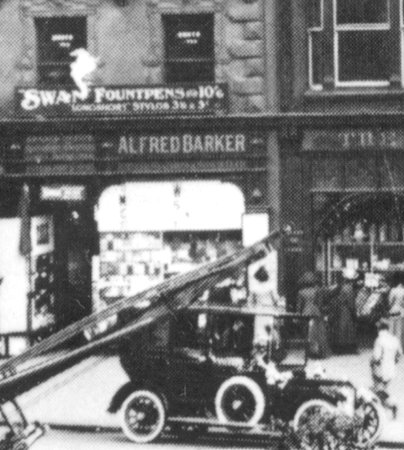 |
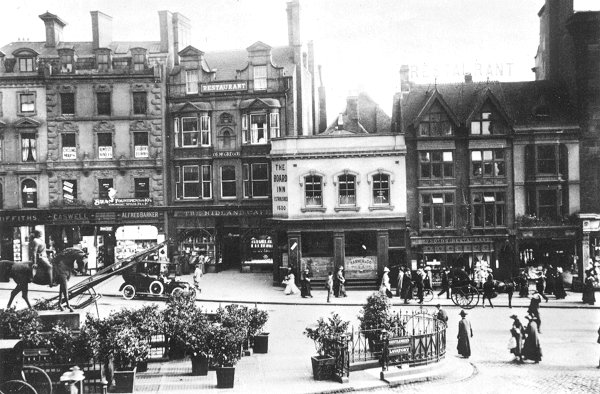
Barker's shop on the south side of
Queen Square is behind the parked car. Photo courtesy of
Eardley Lewis. |
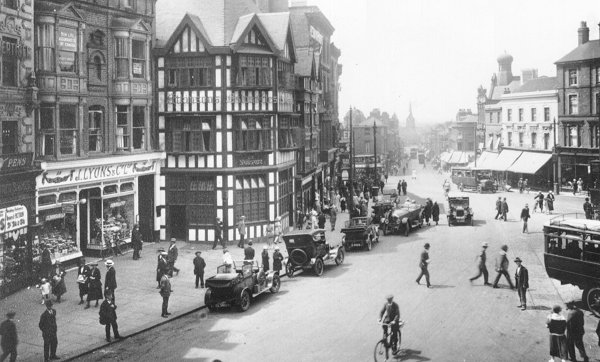
A later view of Queen Square.
Barker's shop is on the extreme left. Photo courtesy of
Eardley Lewis. |
| Barker's Souvenir
Photograph Album |

The front Cover.

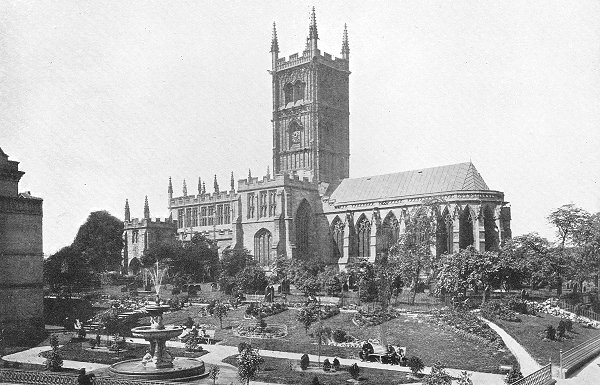 |
A fine view of St. Peter's Church and St. Peter's
Gardens which were laid out in 1883. The gardens were
later extended to cover much of the graveyard which can be
seen in front of the church. |
| The photograph was taken sometime between 1898 and 1902
because the old exchange building (demolished in 1898) is not in the background. |
| A view of North Street with the Town Hall on the left
and the retail market on the right.
On the extreme right behind the people is the public
drinking fountain which was on the market wall.
All of the buildings, except the Town Hall were
demolished in the 20th century. |
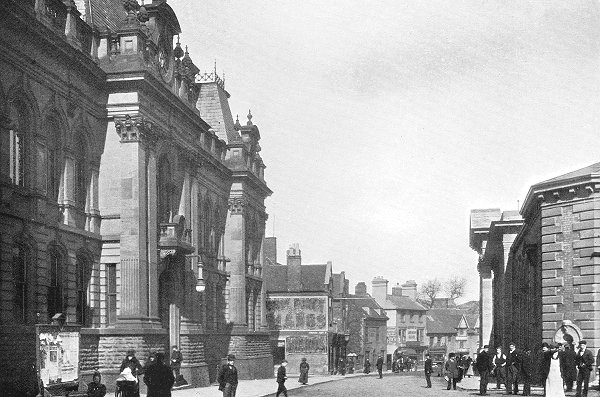 |
| On the left, at the far side of the Town Hall is
Corporation Street. The building with the large sign on its
end wall houses The Empire Fruit Stores that specialised in
home grown fruit and vegetables. In the distance is the Old
Mitre Inn Temperance and Commercial Hotel, and E. Jessop's
hotel and restaurant. |
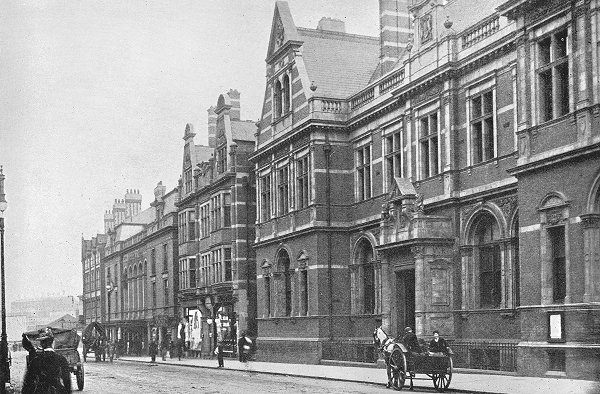 |
The new post office in Lichfield Street which opened on
29th March, 1897, now known as 'the old post office'. In the distance is the Grand Theatre,
the Victoria Hotel, and Victoria Square. |
| The old post office was no longer needed after the
opening of the modern post office in Lichfield Street in
1965, and the subsequent opening of sorting offices in
Horseley Fields, Whitmore Reans and Wednesfield. In the mid
1980s the building was acquired by a Walsall firm of
property developers, and redeveloped for use by
Wolverhampton Polytechnic (now Wolverhampton University).
Laboratories, class rooms, lecture theatres and offices were
installed in readiness for the occupation of the School of
Health Sciences, which moved into the building towards the
end of 1987. The university continued to rent the property
until 2007. At the time of writing this article (mid 2013)
the building is still unoccupied. |
| The Art Gallery which opened on 21st July, 1885. Just
visible on the extreme right is the Royal London Building,
which opened in 1902.
The two buildings on the right of the art gallery were
replaced by the Midland Bank in 1910. |
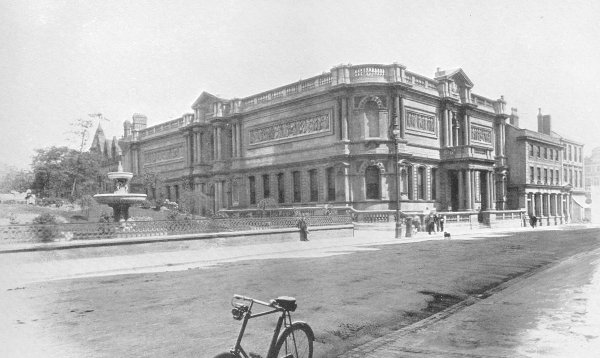 |
 |
The Horsman Fountain next to the art gallery was built
as a memorial to Philip Horsman who died on 14th December,
1890. The unveiling ceremony took place on 23rd May, 1896. |
| Building contractor Philip Horsman became a wealthy man
and an important local benefactor. His company built the
Town Hall and the Art Gallery. He gave £8,000 towards the
building of the Art Gallery, and £5,000 towards the building
of the Eye Infirmary. The fountain carries the following
inscription: "This fountain was erected by public
subscription in grateful recognition of the generosity of
the late Philip Horsman, J.P., who presented the adjoining
art gallery and other philanthropic gifts to the town". |
| A lovely view of a quiet Queen Square with the town's
variety theatre, 'The Empire Palace of Varieties' on the
left.
In the middle distance on the right is a horse-drawn tram
about to set off to Newbridge, via Darlington Street, Chapel
Ash, and Tettenhall Road. |
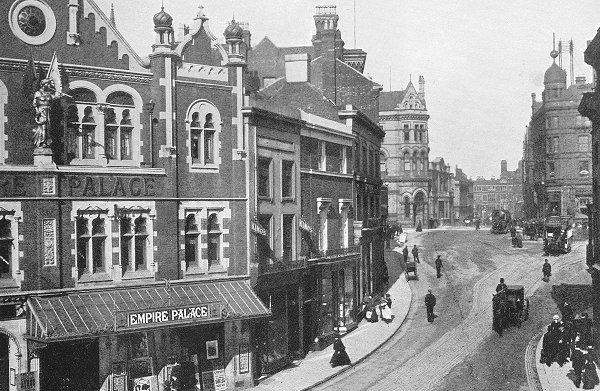 |
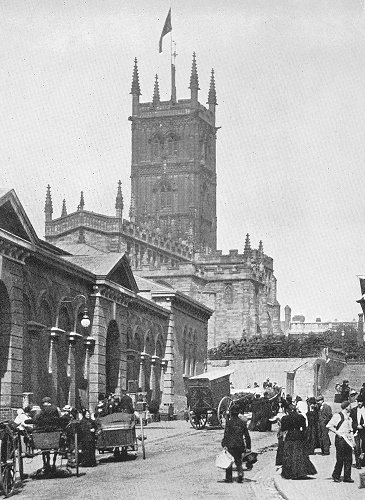 |
Looking into Cheapside, towards St. Peter's Church from
North Street, between 1898 and 1902. The empty space in
front of the church had previously been occupied by the
Exchange Building, demolished in 1898.
On the left is the retail market with its impressive
Italianate classical façade. It had been built at a cost of
£30,000 and opened in March 1853.
After just over one hundred years of use, the well-liked
building closed with the opening of the new retail market in
June 1960. Sadly the fine building was demolished in January
1961. |
| The conservatory in West Park which would have been
quite new when the photograph was taken. It was built from
the proceeds of the town's Floral Fete, and opened on 8th
July, 1896. |
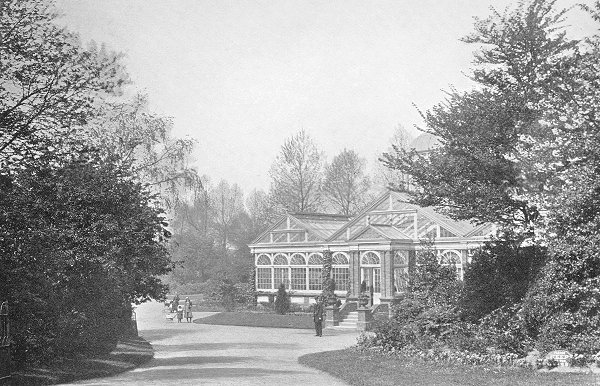 |
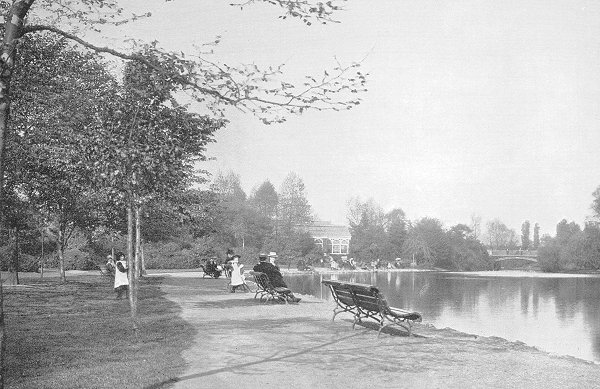 |
A fine view of the lake in West Park, sometime between
1896 and 1902. The park was relatively new at the time
having opened on 6th June, 1881. |
| Looking along Snow Hill towards Dudley
Street, where the Wulfrun Centre now stands. The large
statue which now stands in West Park commemorates the life
and achievements of local MP Charles Pelham Villiers |
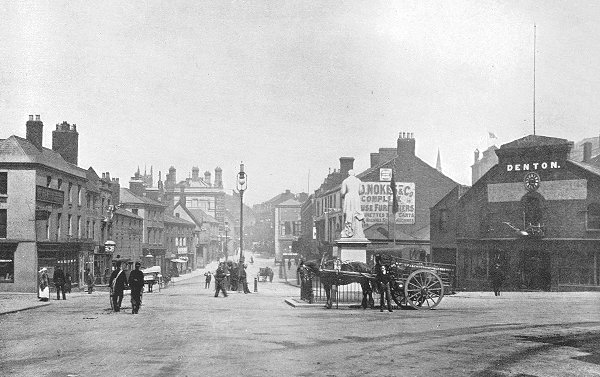 |
| The statue carries the following inscription on the
front: "Charles Pelham Villiers, PC, MP, Born 3rd January
1802, died 16th January 1898, aged 92 years". The
inscription on the back is as follows: "This statue was
erected by public subscription in recognition of the eminent
services rendered by Mr. Villiers to his country, especially
in connection with the repeal of the corn laws. He
represented the Parliamentary Borough of Wolverhampton in
the House of Commons from 1835 until the division of the
Borough in 1885, when he was returned for the South
Division, which he represented until his death." |
 |
The western end of Chapel Ash and the
horse-drawn cabs, the taxis of their day, that stood around
the shelter. On the right a horse-drawn tram makes its way
into Chapel Ash from Tettenhall Road, on its way to the
terminus in Queen Square. |
| Wolverhampton Grammar School on Compton
Road, built in 1875 and extended in 1890. |
 |
 |
Looking south eastwards along a quiet
Tettenhall Road from Newbridge towards St. Jude's Church. |
| A view of Tettenhall Road from Newbridge
looking towards The Rock. In the centre is a horse-drawn
tram starting its journey to the town centre.
The horse-drawn trams terminated at Newbridge because
they were unable to climb The Rock. |
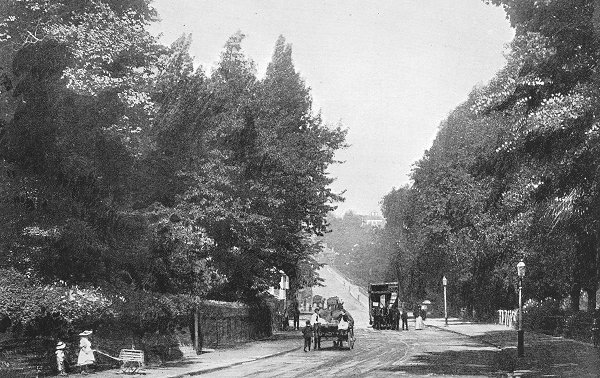 |
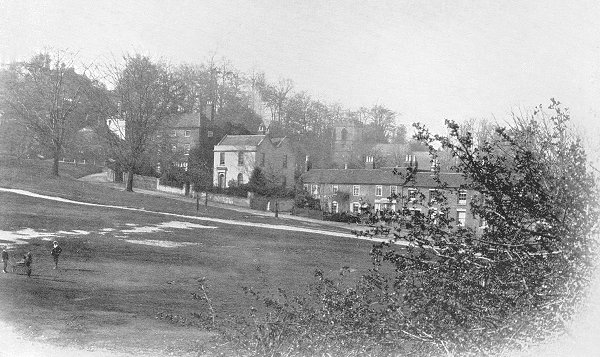 |
Lower Green, Tettenhall with two lovely
houses in the background known as 'The Green House' and 'The
White House'. |
| Looking from Lower Green, Tettenhall towards
the Lich Gate and the Church of St. Michael and All Angels. |
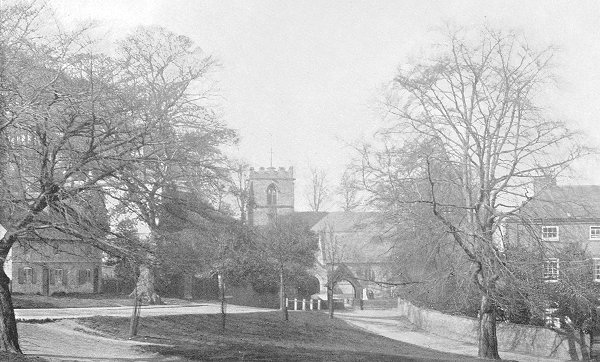 |
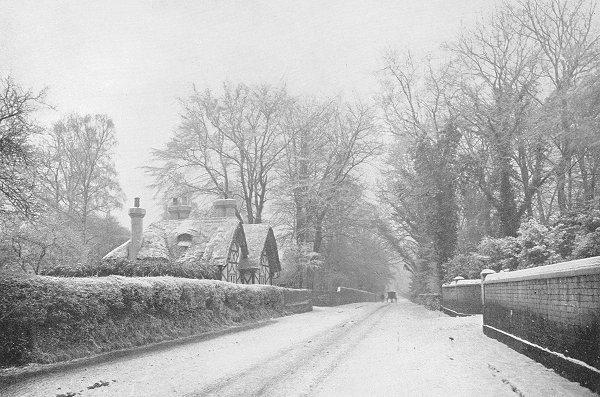 |
Wood Road, Tettenhall in winter, and the
lodge to Tettenhall Wood House, known as Wood House Lodge. |
| Bridgnorth Road at Wightwick looking towards Compton.
The photograph was taken about fifty yards from the modern
traffic lights by The Mermaid pub.
The houses on the left look much the same today. |
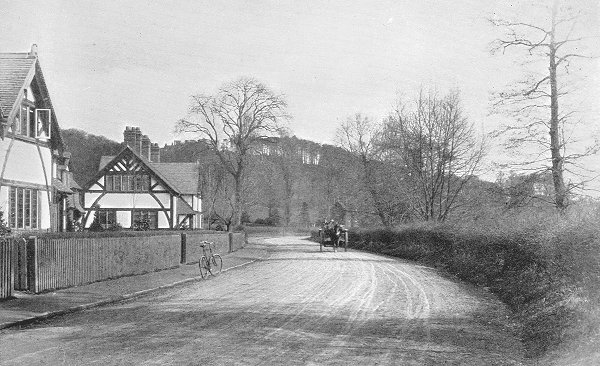 |
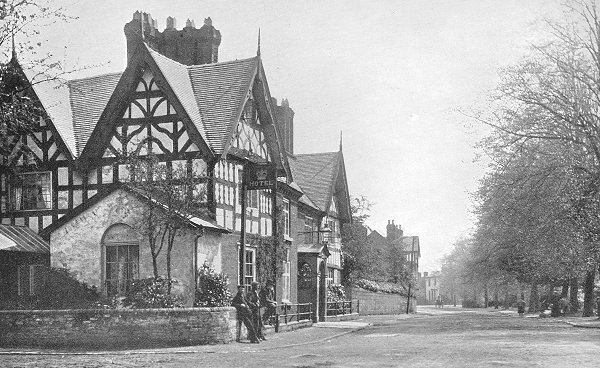 |
A view of 'The Crown' pub in High Street, Albrighton. |
| 17th century Boscobel House, famous as a hiding place
for King Charles II during his escape to France after the
Civil War. |
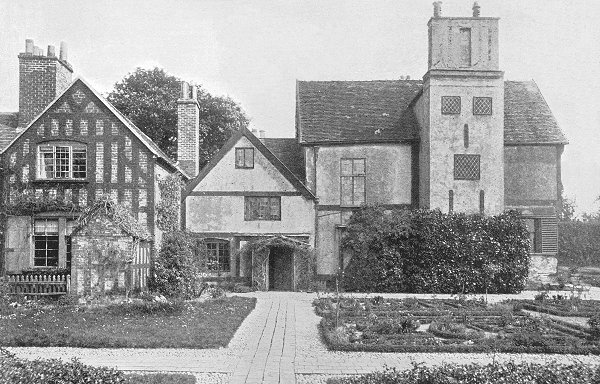 |
 |
Return to
the
previous page |
|